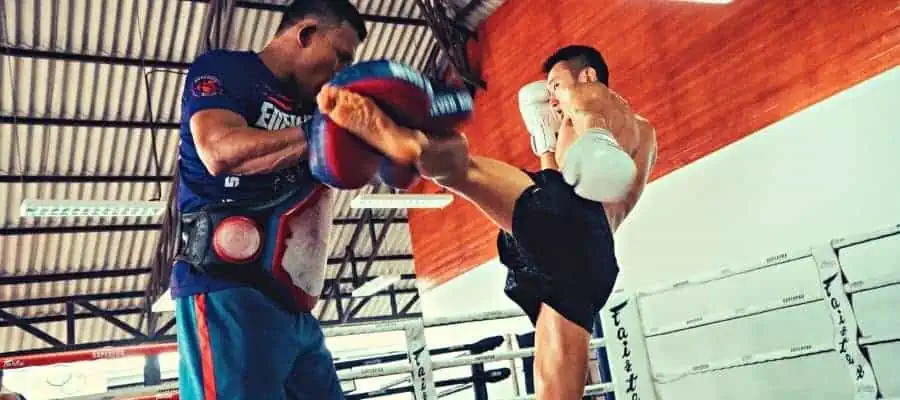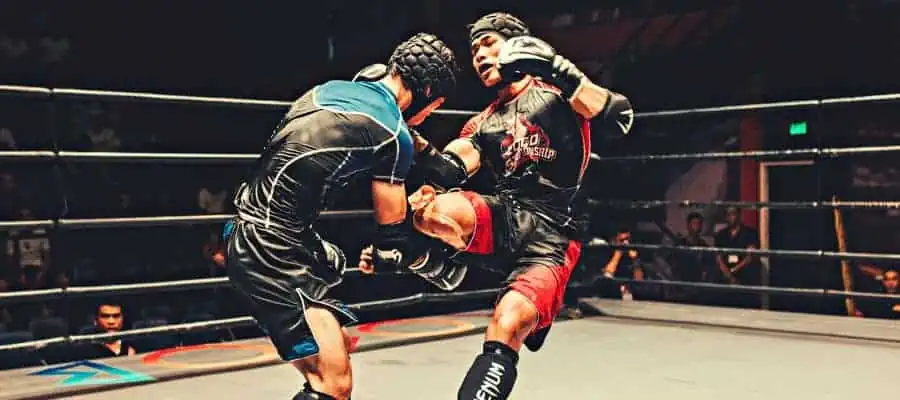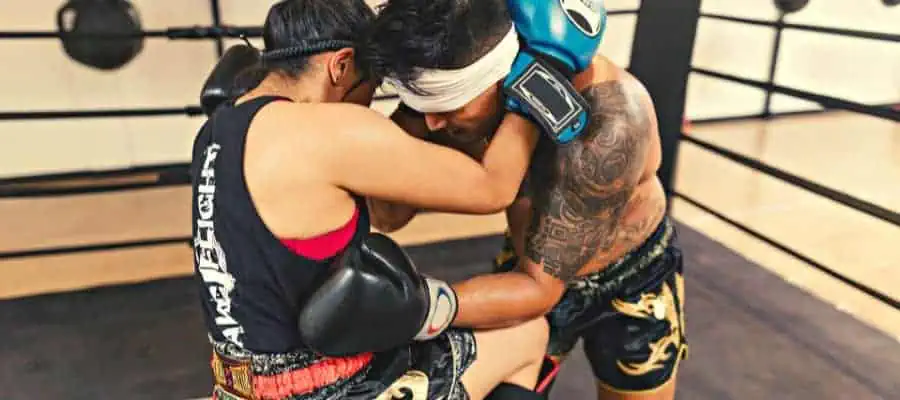What are the requisite attributes for the ideal Muay Thai frame? Also, many people ask if height is a pivotal factor in this martial arts style.
So, does height really matter in Muay Thai? Essentially, weight and height are significant when it comes to combat sports. Rules and regulations have been established to keep bouts as fair as possible. However, there will always be discrepancies in physical attributes – not every fighter can be as vertically blessed as Stefan Struve. Though the differences are there, each body type has pros and cons! So, to an extent, height does matter, the same as weight matters.
But, being too short or tall can play in your favor as much as it can be a hindrance. So if you’re wondering, “how would my body type do in Muay Thai?” or you’re just curious how much of a factor height plays in the sport, we’ll delve a bit more into it! It all depends on how you use your attributes.
What Role Does Height Play For Shorter And Taller Fighters?

Short Fighters
Say a shorter person, perhaps 5’4”, wanted to partake in Muay Thai; they should not be deterred simply because they’re a bit on the short side, but rather, they should give it a go! One of the best Muay Thai practitioners in the world, the 5’4” legend, Saenchai, has blessed audiences with his incredible performances, positive energy, and dynamic finishing ability. He’s quite the showman, and this is thanks to the skillset that he brings to the table.
As a matter of fact, Muay Thai benefits the shorter fighters more than other striking sports such as karate and kickboxing. In Muay Thai, the athletes can use punches as kicks, per the usual striking ruleset. Still, also they can use elbows and knees and clinch with their opponents. This benefits the shorter athletes because it allows them to mitigate an opponent’s reach while also increasingly threatening themselves.
Additionally, shorter fighters tend to thrive in the clinch when challenging taller fighters. It’s often the fighter with the lower hips that will have an advantage when it comes to throws and foot sweeps. Look at Judokas – the attacking athlete will often have lower hips.
This gives them a lower center of gravity, making it hard for them to be countered but very easy to create leverage when tossing an opponent. The same goes for Muay Thai – the shorter competitor will have a lower center of gravity, giving them an advantage they can play to.
Tall Fighters
However, the taller competitors aren’t uncomfortable in the clinch themselves. Bringing a knee up to meet the skull while in the clinch is easy. Furthermore, the elbow attacks from tall and lanky fighters are what Muay Thai nightmares are made of! And this clinch situation is all very presumptuous that the fight even makes it there.
Tall fighters will almost always have the reach advantage in both the arms and the legs. Suppose the taller fighter makes the most out of these attributes and constantly threatens with strikes down the pipe and knees up the middle. This will make anyone feel quite the trepidation to close the distance in fear that they may run face first into the oncoming traffic-Esque plethora of attacks.
So, height does matter in Muay Thai, but there is no correct answer as to which height is ideal; it’s all about the game plan and how a fighter uses their attributes. Tall fighters should use their range via straight shots, teep kicks, and playing their game in the clinch; shorter athletes should work their way into boxing range with their footwork and feints, and that’s when they can have their most success.
Muay Thai is for everyone! Short, tall, big, small, t-rex arms or Mr. Incredible-like limbs – this sport has something for everyone. Sparring and competing will reassure as much as it will humble anyone who finds themselves in the gym or the ring.
This isn’t just a Muay Thai concept; a competitor can thrive no matter their physical attributes with any martial art.
What Exactly Are The Techniques That Favor Different Builds In Muay Thai?

For Taller Fighters
Teep kicks. Teep kicks, also known as push kicks, are leg strikes that keep a fighter at bay. This kick is hard to negate and is a favorite technique amongst the longe rage Thai fighters. Not only does this kick work with great regularity, but it works wonders regarding setting up finishing blows.
Most fighters will defend this kick by dropping their arm and deterring the kick with a windshield wiper-like motion. While this does deflect the kick and can off balance the offensive fighter, it gets the opponent to drop a hand, albeit just for a flash.
Really, the battle of deception can be started with any strike. Still, the teep kick is a very prominent and effective move, whether done to keep the distance, hurt the body or set up more concluding blows. Fighters will often feign the teep kick and then come in with punches or a step-in elbow. This feint will also open up several other kicks.
The jab. The jab is the most essential strike in combat sports. It gauges distance, sets up the significant strikes, reads the opponents’ reaction, and does much damage if appropriately landed. This strike favors the longer fighters because it’s a long, straight shot off the lead arm.
Like the teep kick, the jab helps with keeping the opponent far away. A shorter opponent getting peppered up by jabs while unable to close the distance has been seen repeatedly in combat sports.
Knee strikes. For taller fighters, knee strikes can be their best friend! Those shots can be elusive, for the telegraph is similar to a kick. Additionally, they are absolutely vicious against shorter fighters. Whether thrown from a distance or in the clinch, knee strikes to the head or body have a high percentage of getting the job done.
Knees finish fights, and this weapon’s threat is enough to make a shorter opponent hesitant. This technique works particularly well for taller fighters because the distance between the knee and the opponent’s head isn’t much. Furthermore, even the threat of the knee is enough to make a fighter hesitant to close the distance because they fear that they may run into this strike.
For Shorter Fighters
Footwork/feints. Closing the distance is very important for the shorter fighter if they want to succeed in striking. For a Muay Thai fight, using feints and footwork to close the distance will be very helpful in getting on the inside.
Using feints to make the opponent react and think that a strike is coming is a surefire way to create openings to get in close and land some bombs. Using footwork to gradually inch closer and closer is also a viable way to find the chin of a taller and longer opponent.
If the fighter knows how to do some footwork techniques, it can be a pivotal point in his success. For example, cutting off the ring rather than circling with the opponent, creating angles to penetrate their defense or any numerous ways to enter boxing range while mitigating the oncoming danger.
Body shots. For the shorter fighter, attacking the body could be the most paramount approach to taking on a taller fighter. To do this, the shorter fighter will need to use footwork and feints to work their way to the inside, where strikes will be thrown at a range that favors them instead of at a distance where the taller fighters can thrive.
Landing body shots can easily win a fight. Fighters are all tough, but nobody can out-tough getting hit in the liver. To stop these shots from landing, the taller fighters need to drop their guard, and voila, the chin is now exposed.
Of course, it’s always best to mix up attacks, so alternating from the body to head is when shorter fighters can make discomfort for the taller opponent.
Clinch fighting. Fighting in the clinch can benefit tall and short fighters. Still, it is often better than fighting at a distance where taller opponents can land and shorter fighters cannot. Once again, using footwork and feints to close the distance, a shorter fighter can wrap up their opponent and thwart the reach advantage.
Using elbows, knees, and sweeps from the clinch will have the judges siding with the shorter athlete. That’s assuming the fight goes to the decision; shorter fighters are likely to finish fights from the clinch because they can generate much power with little room to work.
Other Martial Arts That Work For Shorter Fighters

Judo
Judo is actually really great for shorter athletes! Judo focuses on trips and throws, using the opponent’s momentum as a weapon against them. Judo is performed while in the gi, but its teachings can be applied to other martial arts and self-defense.
Judo benefits the shorter people because the action takes place in close quarters. Additionally, when performing a throw, it’s essential to have lower hips than the opponent. Being the shorter athlete, a lower base and center of gravity is inherent in the build. This is why shorter athletes would not only benefit from Judo but would actually play very well in their favor.
Sambo
Sambo is a Russian martial art similar to MMA regarding the rules and strikes. Still, the significant difference is that the athletes compete in a gi top and wear headgear. This martial art benefits shorter fighters because of the gi.
Once again, sports involving a gi are great for shorter fighters because fighting in close is after wearing that gear. Throws and trips are easier for shorter fighters when utilizing the gi, and typical takedowns are easier to achieve when a person is shorter than their opponent.
Brazilain Jiu Jitsu
Brazilian Jiu Jitsu benefits any and all bodies, but short and stocky frames are more than successful when training this grappling art. Shorter athletes can make benefit more from being lesser than in terms of height, whether in the gi or not,
Takedowns and throws are much easier, and your guard is a bit more compact, along with chokes such as triangles and rear naked. On top of that, having shorter limbs gives opponents a little less to work with in terms of joint locks. And snatching armbars and attacking legs is very difficult when there’s not a lot of arm or leg.
Wrestling
The prototypical wrestling build is short and stocky. Wrestlers are often not very tall but are very dense in muscle mass. Being shorter and having a lower base makes the distance from A to B much shorter, and that’s a great help to scoring takedowns.
Wrestling may actually be the best martial art for shorter builds! The success rate with shorter athletes in wrestling makes it hard to argue against a short and stout being the quintessential build for the sport.
Boxing
Boxing, similar to Muay Thai, benefits shorter fighters if they follow the abovementioned steps to penetrate a taller opponent’s range. When matched by weight, the shorter fighter usually has the powerful shots, making their shots landing a bit more explosive and lethal than the taller fighters.
However, shorter fighters must fight smarter than athletes with more beneficial natural attributes. But nobody will complain about having a reach advantage. Still, they’ll wish they had shorter arms when fighting in the proverbial phone booth.
Kickboxing
Kickboxing is another excellent martial art for shorter builds. It is because, on top of the boxing, they’re allowed to use those tree trunk-like legs to drive into their opponent’s thighs, calves, and ribs. In general, kickboxing plays into tall fighters as well as it plays into short fighters. But the latter athlete can be very, very successful if they use their tools the right way.
Get on the inside, kick and punch like their life depends on it, separate and repeat – that will make a shorter athlete a ferocious kickboxer.
How Do Any Of These Martial Arts Help Taller Fighters?

Judo
Judo can favor taller and lankier practitioners if they maximize their length. Using their height for leverage can make it difficult for shorter athletes to close the distance, break posture and perform a throw.
Also, foot sweeps are pretty successful in Judo! These sweeps are a bit easiest for taller practitioners because they can use their leverage(height) to manipulate their opponent’s direction and lead them into a sweep.
Sambo
Sambo works for taller fighters if they can utilize front kicks and straight punches to avoid their gi being grabbed. Additionally, assuming a tall fighter wants to stay standing, uppercuts thrown or feinted will make a shorter opponent hesitant to shoot a takedown.
Brazilian Jiu Jitsu
BJJ also plays into taller practitioners! Try passing a tall person’s guard and not cursing at them for having beneficial but annoyingly long legs. You won’t. Long limbs make attacking armbars, throwing up triangle chokes, and taking opponents’ backs much easier.
Really, it’s all about how a practitioner plays their game. Tall or short, heavy or small, male or female – Brazilian Jiu Jitsu is for anyone and everyone!
Wrestling
Wrestling favors shorter competitors more than other martial arts, but tall people can make it work for them! Making the most out of their wizard or overhook and hitting tosses, lateral drops, or trips will play into a taller competitor’s game.
Boxing
As stated earlier, jabs are a tall fighter’s best friend. A solid and hard-to-read jab will make a tall fighter so much more difficult to touch, let alone knock out. Changing the target from the head to the body will add some diversity to this one punch.
Not hard enough? Throw the cross! Fighters should try and make their cross as straight and piston-like as the jab. It’ll be a bit slower because there’s more distance to cover, but it hits much harder.
Kickboxing
Like the jab in boxing, kickboxers will also use this to maximize their length in kickboxing. That’s not it, though! Teep kicks, snapping front kicks, and leg kicks will keep shorter fighters at bay.
Kickboxing helps the taller fighters if they can fight smart and remain calculated for the entirety of the bout. Again, shorter fighters often hit harder, so keeping the bout a long-range one with the previously listed techniques is the move.
Recent Posts
What is Manachai's Fighting Style? Unveiling Muay Thai Mastery
Manachai, a celebrated figure in the Muay Thai world, has captivated audiences with his exemplary martial prowess. Hailing from the heartlands of Thailand, his name is synonymous with the art of...
What Was Chamuekpet Hapalang's Fighting Style? Unveiling Techniques
Chamuekpet Hapalang was a renowned figure in the world of Muay Thai (record 200-48-2), embodying a fusion of Muay Bouk and Muay Khao styles. Originating from Thailand, the art of Muay Thai is known...
